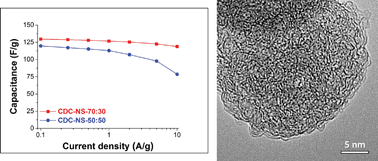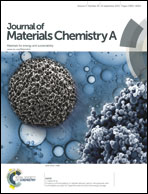Emulsion soft templating of carbide-derived carbon nanospheres with controllable porosity for capacitive electrochemical energy storage†
Abstract
A new approach to produce highly porous carbide-derived carbon nanospheres of 20–200 nm diameter based on a novel soft-templating technique is presented. A platinum catalyst is used for the cross-linking of liquid (allylhydrido)polycarbosilane polymer chains with para-divinylbenzene within oil-in-water miniemulsions. Quantitative implementation of the pre-ceramic polymer can be achieved allowing precise control over the resulting materials. After pyrolysis and high-temperature chlorine treatment, the resulting particles offer a spherical shape, very high specific surface area (up to 2347 m2 g−1), and large micro/mesopore volume (up to 1.67 cm3 g−1). The internal pore structure of the nanospheres is controllable by the composition of the oil phase within the miniemulsions. The materials are highly suitable to be used as supercapacitor electrodes with high specific capacitances in aqueous 1 M Na2SO4 solution (110 F g−1) and organic 1 M tetraethylammonium tetrafluoroborate in acetonitrile (130 F g−1).


 Please wait while we load your content...
Please wait while we load your content...